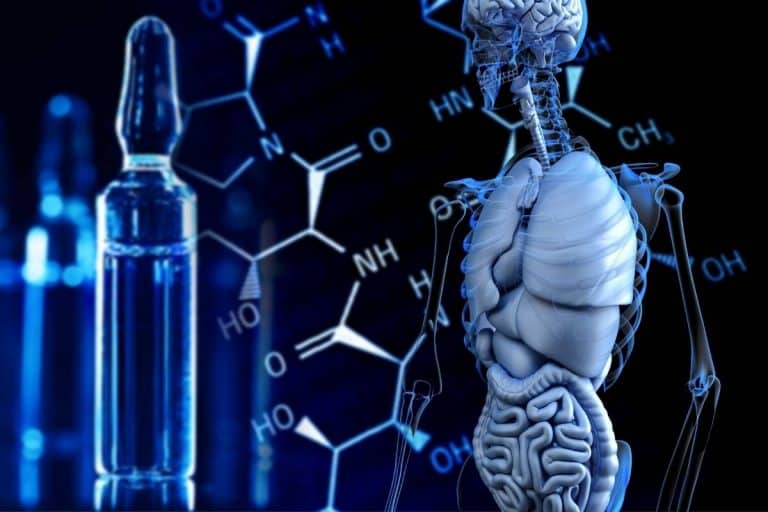Do You Need Chemistry for Anatomy and Physiology?
Planning your college course schedule can be challenging. You need to make sure you are fulfilling the minimum credit requirement to stay enrolled and ensure that you have enough free time to complete your coursework. If you’re in an intensive major such as one of the life sciences or something health-related, you will have many course requirements and not a lot of time to fulfill them, so you’ll need to decide what you really need for your program.
You don’t need chemistry for anatomy and physiology, but it is a vital component of all sciences, and it is essential in understanding anatomy and physiology. Whether or not you’ll need to take it ultimately depends on your program. You should consider it for valuable experience in future classes.
Having even a basic knowledge of chemistry will provide numerous benefits in subsequent Anatomy and Physiology-related courses and future science courses of all types. This article will explore some of the connections between chemistry, anatomy, and physiology, and why you should consider taking a chemistry course before diving into the latter subjects.
What To Consider Before Taking Chemistry
Managing your time and workload efficiently when registering and enrolling in college courses can be something of a game.
Certain classes might cover multiple requirements or provide more, or less, credits than what you need to graduate. That’s why it is always important to consult your academic advisor when considering and creating your course schedule at the beginning of a semester.
Your academic advisor might not know precisely why a chemistry course may or may not be a good option for you, but they will know whether it is required to complete your degree.

This is something you should consider before anything else: Is it a requisite course?
Many health and life science-related programs require that you take chemistry, potentially even before you can consider taking anatomy and physiology courses. If it is a requisite, you’ll have some other considerations to make.
Should you take it before, after, or even during anatomy and physiology if you have the option?
Again, the answer to this will depend on your specific situation. Many schools require you to take Chemistry before you can take Anatomy and Physiology. At others, you may have some freedom when you can take it.
Because Chemistry contains many foundational concepts that are expanded upon in Anatomy and Physiology, it is highly recommended that you take it before moving on.
Alternatively, you could try to take Chemistry as well as Anatomy and Physiology at the same time.
Some may find this beneficial, while others may want to consider the effort and time involved in doing so. Colleges typically recommend against taking more than one lab course per semester.
This is because they are about twice the length of a standard class and require just about twice the work as well.
However, if you’re confident you’re up to the task, this may be a great way to save time and money by consolidating your workload.
Chemistry Is the Functional Component of Anatomy and Physiology
Beyond whether a chemistry class is required to complete your degree, you might be wondering just how chemistry is related to anatomy and physiology. The truth is, chemistry is the core component of anatomy and physiology, along with other foundational subjects like math, physics, and biology.
You can think of the combined subjects of anatomy and physiology like a pyramid. On the bottom, you have the foundational component: math. Chances are, if you’re interested in going into any science field, you’ll have the basic math skills you’ll need to get by.
The next level up is physics.
While it isn’t as integral as chemistry, an understanding of fundamental physics can help you understand the functions of the body. Unless it is a requirement, a physics course will likely not be essential.
However, if you have the opportunity to take one, you will indeed find it beneficial.
The second to last level, right under biology as the integrated component, lies chemistry. Its place is high up on the pyramid because it is integral to understanding how anatomy and physiology work together.
Chemistry Is a Fundamental Science For Daily Life
Anatomy and physiology can be considered specific subjects within the larger health sciences.
Conversely, chemistry is a fundamental science that affects everything we do. Chemistry is so common, in fact, that everyone performs some form of it every day, from cooking to cleaning and everything in between.
Put simply, chemistry is the study of changes in matter when it is exposed to different conditions.
It involves breaking substances down to their most basic components and understanding how they are affected by various changes in their environment. Think of butter melting in a pan or water freezing into ice cubes.
Not only does their state of matter exist—from solid to liquid and vice versa, respectively—but their shape and mass change as well.
Chemistry is typically thought of as a physical science as it does not involve living things.
The chemistry concerned with the operation of a living thing is known as biochemistry. Biochemistry is what you’ll be dealing with when learning anatomy and, more specifically, physiology—how the different elements of the human anatomy function and work together.
Anatomy Is Basically the Human Body
On its own, anatomy is a fundamental concept. You could theoretically get by understanding anatomy without knowledge of chemistry. This is because anatomy only deals with structure, including the names and locations of the parts of the physical human body.
Gross Anatomy
“Gross” in this case does not refer to repulsion. However, since gross anatomy can involve dissection and autopsies, it certainly is a fitting name. Here, gross refers to the sum or whole of the body and involves the systems of the body that are visible to and can be studied by the naked eye.
There are a total of 11 systems, including the skeletal and muscle systems, the respiratory system, and the nervous system, among others.
Source: Medical News Today: Anatomy: A Brief Introduction
Microscopic Anatomy
As can be inferred by the name, Microscopic Anatomy is the opposite of gross anatomy, as it deals with the parts of the body that cannot be studied by the naked eye and require the use of tools like a microscope.
It is split into two subsections:
- Cytology, which studies cells.
- Histology, which deals with biological tissues.
Source: Lumen: Overview of Anatomy and Physiology
Physiology Studies the Functions Of the Body
Anatomy deals only with the names and locations of the bodily systems, while physiology is the study of the functions and interactions of those systems. It can be thought of as the study of life, or how each part of our body works together to keep us alive.
As the body uses chemical processes to function, this is where an understanding of chemistry really comes into play. Let’s now look at some essential physiological concepts that involve chemistry.
Breathing
One of the most straightforward chemical processes that occur in the body is the intake of oxygen, its conversion, and the output of carbon dioxide. This process should be familiar to everyone as the everyday act of breathing.
Our body requires oxygen to perform countless tasks, from something as simple as thinking to activities that require more energy, like exercise. When you breathe in, your body quickly extracts the appropriate amount of oxygen needed to continue the task. This oxygen travels through the bloodstream to get where it needs to go.
When you breathe out, you release carbon dioxide, a waste byproduct of that chemical reaction.
Source: British Lung Foundation: How Your Lungs Work: Why Do You Breathe?
Cell Structure
Our body is made up of cells. Those cells, in turn, are made up of chemicals that provide specific benefits or functions.
You will find that a chemical known as lipids makes up the cell wall at the foundational level. Lipids prevent any other chemicals from passing through the cell membrane and interrupting the function of the cell.
Speaking of cell functions, one of the most basic chemical reactions performed by a cell involves the production of proteins. Proteins are used to make more cells, carry oxygen through the body, and protect against diseases.
Source: Sciencing: Why Is Chemistry Important to the Study of Anatomy and Physiology?
Osmosis
The previously mentioned lipids that comprise the cell wall make up what is known as a semipermeable membrane. This means that it selectively allows certain substances through.
In the case of Osmosis, this substance is water.
The body is primarily made up of water, and as such, cells are constantly surrounded by it. There is a lower concentration of water inside the cell compared to outside of the cell. This initiates a process called diffusion: water moving into the cell without expending energy.
Water flowing through a cell this way is called Osmosis.
Source: Brooklyn College: Cell Biology: The World of Cells: Osmosis
Adenosine Triphosphate (ATP)
One key component of the structure and function of cells involves a molecule known as adenosine triphosphate or ATP. It is the body’s primary energy source, and is the result of multiple essential chemical processes like cellular respiration, fermentation, and photophosphorylation, the conversion of energy from sunlight.
Source: Biology Dictionary: Adenosine Triphosphate (ATP)
Blood Acidity and Alkalinity
In Chemistry, the acidity of a substance, or lack thereof (known as alkalinity), is measured in pH, which stands for “power of Hydrogen.”
A low pH represents a high number of hydrogen ions, while a high PH means the opposite, or an increased number of hydroxyl ions. Typically, most acidic substances have a pH of 14, while substances with an average amount of acidity have around 7.
When studying the human body, pH plays a vital role in determining blood acidity.
The body maintains a pH of around 7.4, but it can range anywhere from 7.35 to 7.45. An imbalance of blood acidity can interrupt the normal operations of all your vital organs. Your body can balance the pH of your blood by expelling carbon dioxide from the lungs.
Additionally, your kidneys play an essential role by altering the number of acids and bases it releases.
Source: Merck Manual: Overview of Acid-Base Balance
Nutrition
Nutrition and chemistry go hand in hand, as nutrition is often referred to as “the chemistry of life.” Indeed, knowing how your body reacts to chemical substances in food, such as vitamins, is key in balancing a healthy diet.
These chemical substances found in food and beverages are called nutrients and include carbohydrates, proteins, fats, vitamins, and minerals. Knowing the chemical makeup of foods and keeping track of how your body processes them is a Chemistry concept through and through.
Students looking for a degree in nutrition will likely find that a Chemistry course is almost certainly required, alongside Anatomy and Physiology.
Source: MedlinePlus: Definitions of Health Terms: Nutrition
You May Only Need One or the Other
As should be clear, the answer to “do I need chemistry for anatomy and physiology?” is not a simple one. Check to see if Chemistry is a required class for your major. If it is, it’s highly recommended that you take it before or with Anatomy and Physiology, as a basic knowledge of Chemistry will be a massive help in understanding physiology.
If your major does not require a Chemistry course, you’ll have to make some considerations. If you are going into a life science or health-related field, Chemistry will benefit you beyond the basic concepts needed for anatomy and physiology.
For example, Chemistry plays a significant role in nutrition and will likely be a required course for Nutrition majors.
Conclusion
Perhaps you’ve already taken anatomy and physiology and found yourself wondering if chemistry would supplement your current knowledge. The critical connection between chemistry and all sciences, including anatomy and physiology, should be clear no matter your situation. While you might not need chemistry for anatomy and physiology, you should absolutely consider taking it to strengthen your skills in the subjects.







